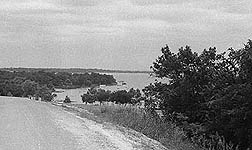 The
streets were laid for the Forest Hills and Lakewood subdivisions
in the mid-20s, and on the hill above the present club in the early
30s. People were moving toward the lake. But, the lake was still
far from Dallas' center of population. Old boat houses can be seen
in the 1936 photo from Buckner near where it crosses Mockingbird
Lane today. These can also be seen in the background of several
of the photos in the previous section. These housed power boats.
Several were owned by John Williams, who had a power boat marina
and owned the Bonny Barge. Williams' marina was located just south
of were CSC is located today.
The
streets were laid for the Forest Hills and Lakewood subdivisions
in the mid-20s, and on the hill above the present club in the early
30s. People were moving toward the lake. But, the lake was still
far from Dallas' center of population. Old boat houses can be seen
in the 1936 photo from Buckner near where it crosses Mockingbird
Lane today. These can also be seen in the background of several
of the photos in the previous section. These housed power boats.
Several were owned by John Williams, who had a power boat marina
and owned the Bonny Barge. Williams' marina was located just south
of were CSC is located today.
As White Rock Lake continued to grow in popularity, Dallas civic
leaders started considering a permanent city park on the shores
of the lake. Shortly after being elected mayor in May 1929, J. Waddie
Tate proclaimed that it was his desire "to see White Rock beautified
and amusements, which will give the people of Dallas a first class
pleasure resort, installed on the north side of the lake as soon
as possible." The land around the reservoir was transferred
to the park department and White Rock Lake Park was created in December
1929.
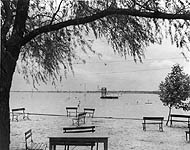 In
1930, the city opened a 500 ft. long, sand, swimming beach (photo)
and bathhouse at the site of today's Bath House Cultural Center.
Many of the swimmers rode public transportation to the lake. The
trolley line was extended to within 5 blocks of the concrete boathouse
that still stands at the southwest corner of the lake. There bathers
could transfer to a "fast motorboat" to cross the lake
to the beach. The bathhouse was built so that swimmers had a place
to change from street clothes into their bathing suits and then
shower before returning home. Bathing apparel and beach towels could
be rented from a concessionaire. The beach was a success and attracted
100,000 swimmers each summer. Checkout the diving board on the concrete
platform, which is still there. Food concessions were located on
the bathhouse's lower level were vendors sold hot dogs, hamburgers
and soft drinks.
In
1930, the city opened a 500 ft. long, sand, swimming beach (photo)
and bathhouse at the site of today's Bath House Cultural Center.
Many of the swimmers rode public transportation to the lake. The
trolley line was extended to within 5 blocks of the concrete boathouse
that still stands at the southwest corner of the lake. There bathers
could transfer to a "fast motorboat" to cross the lake
to the beach. The bathhouse was built so that swimmers had a place
to change from street clothes into their bathing suits and then
shower before returning home. Bathing apparel and beach towels could
be rented from a concessionaire. The beach was a success and attracted
100,000 swimmers each summer. Checkout the diving board on the concrete
platform, which is still there. Food concessions were located on
the bathhouse's lower level were vendors sold hot dogs, hamburgers
and soft drinks.
Despite significant opposition to creating a Coney Island like
park, several concessions were approved. A dance pavilion featuring
a huge concrete slab that could accommodate large crowds was constructed
near the bathing beach. Dances were held every night except Sunday
during the summer. Music was provided by an all female orchestra, 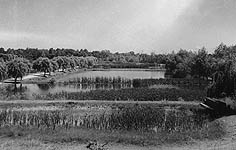 the
Rhythm Sweethearts. The pavilion proved
so popular that it nearly paid for itself during the first summer
of operation.
the
Rhythm Sweethearts. The pavilion proved
so popular that it nearly paid for itself during the first summer
of operation.
There was also a very nice restaurant on the south shore of Sunset
Bay complete with quarters for the keeper. It was called the Sunset
Inn.
In 1934, a municipal fish hatchery was
built on several acres below the dam (photo above right) to stock the
lake with a variety of edible fish. The yearly production eventually
reached 1 million fish.
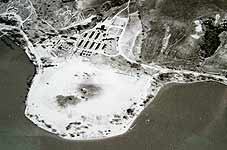 During
the Depression between 1935 and 1942, the Civilian
Conservation Corps, as part of the National Park Service, established Camp 2986 (photo) beside the
lake where Winfrey Point is now. The 250 young men working there
were paid $30 a month. The National Park Service worked with the
Dallas Park Board to make many improvements around the lake. One
of their projects was to remove the fishing cabins and boathouses.
During
the Depression between 1935 and 1942, the Civilian
Conservation Corps, as part of the National Park Service, established Camp 2986 (photo) beside the
lake where Winfrey Point is now. The 250 young men working there
were paid $30 a month. The National Park Service worked with the
Dallas Park Board to make many improvements around the lake. One
of their projects was to remove the fishing cabins and boathouses.
Winfrey Point was built to provide a place for folks to go after
the cabins were torn down. The building could be used by anyone
based on a first-come, first-served reservation system. 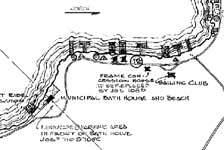 The
Big Thicket, Doran's Point (by Flag Pole Hill), many picnic structures,
and the seawall around the lake were also built by the CCC. A map of planned CCC projects, drawn by the National Park Service in 1936,
shows the location of the DSC clubhouse, docks and boat houses seen
in the photo at the top of the page (map right). Note the motorboat
concession dock just south of the bathhouse where the water taxis
docked.
The
Big Thicket, Doran's Point (by Flag Pole Hill), many picnic structures,
and the seawall around the lake were also built by the CCC. A map of planned CCC projects, drawn by the National Park Service in 1936,
shows the location of the DSC clubhouse, docks and boat houses seen
in the photo at the top of the page (map right). Note the motorboat
concession dock just south of the bathhouse where the water taxis
docked.
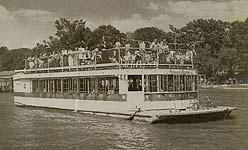 In
1937, White Rock Lake park hosted 740,000 visitors. According to
the National Park Service, it was the most visited municipal park
in the nation. In 1938, the Bonnie Barge (photo) carried 150 passengers
who paid 35 cents each for an hour-long excursion. The barge, along
with a speed boat concession, was operated by John Williams from
a dock located close to where CSC's south gate is currently located.
The barge was 65 feet long, 22 feet wide and was equipped with a
jukebox and two dance floors. Dance music was provided each evening.
The Bonnie Barge operated through 1956 when it was removed along
with the speedboat concession and other businesses around the lake.
In
1937, White Rock Lake park hosted 740,000 visitors. According to
the National Park Service, it was the most visited municipal park
in the nation. In 1938, the Bonnie Barge (photo) carried 150 passengers
who paid 35 cents each for an hour-long excursion. The barge, along
with a speed boat concession, was operated by John Williams from
a dock located close to where CSC's south gate is currently located.
The barge was 65 feet long, 22 feet wide and was equipped with a
jukebox and two dance floors. Dance music was provided each evening.
The Bonnie Barge operated through 1956 when it was removed along
with the speedboat concession and other businesses around the lake.
Not long after World War II began, the CCC program came to an end.
The old CCC camp was used by the US Army Air Corps as an induction
center where many young Dallasites attended boot camp before shipping
overseas. In 1944, the Army converted the boot camp to a prisoner-of-war
camp to house 300 German prisoners captured in North Africa, who
were members of Gen. Rommel's Afrika Corps. Since the boot camp
was not enclosed, the prisoners were provided barbed wire and asked
to build an 8-foot fence around their compound. The POW camp was
deactivated in 1945 and deeded to the City of Dallas in 1946 for
a nominal sum. SMU used the barracks as housing for approximately
250 veterans who attended school on the GI Bill following the war.
The buildings were removed after the students left in 1947.
Lake Dallas was the city's exclusive water supply in the 1930s.
The city had only a four-month supply of water left during a 1952
drought. The city again tapped White Rock Lake for emergency water.
The swimming beach was closed in 1952 and never reopened. Dallas
continued to draw water from the lake until it closed down the pump
station for good in 1964.
A city ordinance was passed in 1958 forbidding boats with engines
larger than 10.5 horsepower on the lake. Skis, surfboards and sailboards
were also banned. The lake has since been the domain of sailors,
kayakers, rowers and fishermen.
The Dallas Parks Department had developed a new master
plan for the
park. The park department, using bond and private funds, embarked on a major program to upgrade other park facilities around the lake – roads and parking lots, jogging/bike trails, landscaping, dog park, lighting, signage… which ran into the mid-2010s. The master plan provided a vision, but has not been strictly followed.






